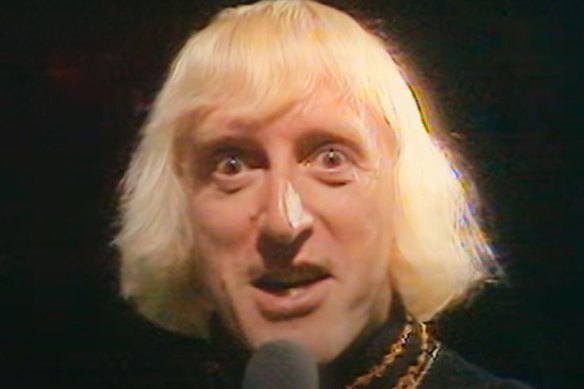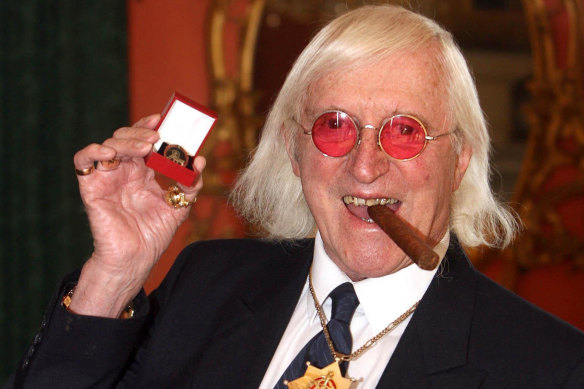This was published 3 years ago
Jimmy Savile: The perverted entertainer who tricked a nation, including me
By Sarah Thomas
WARNING: This story contains content that could be distressing to some readers.
How do you explain to the world that a beloved British TV icon was also the nation’s most prolific sex offender – and it was all in plain sight?
And how do you explain that this sex offender, Jimmy Savile, was a childhood hero of mine, and so many other kids growing up in Britain at that time?

Jimmy Savile tricked the British nation.Credit: Netflix
For Australian audiences, it must be a baffling story. Believe me, for us Brits, it is beyond baffling.
Yes, there’s the blindingly obvious, as Netflix’s two-part documentary Jimmy Savile: A British Horror Story lays brutally bare to the world in its archival footage: the creepy gags and touchy-feeliness on live TV; a lifelong, slightly odd bachelor life; the TV and charity work centred around children. And, then, you know, just look at him.
But he got away with everything.
After all, he was on TV.
The story of Jimmy Savile is an utterly bewildering, sickening insight into the depths of evil. He died in 2011, with a headstone, later removed, that said: “It was good while it lasted”. He never faced any charges while alive. It was only after he was dead that the cavalcade of allegations began.
Between 1955 and 2009, Savile sexually abused at least 450 people aged between 5 and 75. At least 72 victims were linked to his work with the BBC. Many assaults happened in at least 30 hospitals, hospices and other facilities where Savile’s extensive charity work had afforded him lord-of-the-manor status, with full, unsupervised access to places like patient wards and hospital mortuaries. Over decades, under the guise of charity, he deliberately, strategically targeted the most vulnerable.
This all sat secretly beneath his fame: a lengthy career at the BBC, as the first and long-running presenter of music chart show Top of the Pops, (1964-2006) and with Jim’ll Fix It (1975-1994), where kids would write in and he’d make their wishes come true, whether to ride in a James Bond car, or be a princess for a day.
I grew up in this Britain, where Savile held court. I saw him once in person, at the christening of the Queen Mary 2 cruise liner in 2004, attended by Queen Elizabeth II and various notables from British entertainment and the establishment in all their finery. And there was Savile, wearing a polyester leopard-print tracksuit – reassuringly eccentric and ridiculous, his go-to strategy in disarming people.
It’s this that takes A British Horror Story beyond a true crime documentary. We know who the culprit was and what he did. But it’s the how, the story about the culture that permitted Savile’s behaviour. Why the police, the media, the establishment and the British people were all to some extent complicit, unwittingly or otherwise.
Director Rowan Deacon films some of her subjects – Savile collaborators, journalists – up close while they’re revisiting some of those questionable moments from the archives. You see the awkwardness, the wincing, the shifting in the chairs. Ah yes, that was weird, now that you mention it.
There has been a massive cultural shift over recent decades, that makes watching the series more confronting. It has been a long and painful road to where we are, where allegations against people like Michael Jackson, Gary Glitter, Bill Cosby and so many more, finally put on the radar that celebrities were capable of abusing their power, and how difficult it was for people to speak up against them. Beyond that, Weinstein and #MeToo have given us the words and power to identify and challenge abuse.

Savile pictured in 2008. Credit: AP
As Meirion Jones, one of the first journalists who pursued the Savile angle of abuse, sparked by the celebrity’s visits to Duncroft House, a children’s home run by Jones’ aunt, says in the documentary: “I didn’t realise the whole world around him had to change before the truth could come out.”
One of the few positives we can glean from this horrific story is the importance of victims being seen, heard and believed.
Sam Brown was regularly molested by Savile between the ages of 11 and 15, as she helped out in the presbytery of a hospital church, she discloses in the documentary. Despite her protests, her mum still made her go. At first, she resorted to wearing several pairs of underwear and inserting tampons into her prepubescent body as desperate but futile barriers to his abuse. She remembers thinking, why couldn’t the congregation see it, see her, when they were just metres away behind an ajar door?
When the allegations about Savile finally started to seep out after his death, she went to the police, where the first thing she did was apologise for taking up their time. She was in her 50s, having spent an adult life in a state of self-loathing. “I was really aware that I needed to start talking and stay talking. And that’s what I did, and actually I can kind of look at my young me ... with less pain now.”
Another program will air later this year, a BBC drama, The Reckoning, with Steve Coogan as Savile. The program makers have said they worked closely with victims to handle the story with “sensitivity and respect”, but there has been some outrage among the wider British public. People think it’s still too soon to turn this painful chapter into a drama.
“I think that’s because Jimmy Savile played a trick on the entire nation so there’s a real feeling of antagonism about it,” Coogan said of the reaction. “But you need to look at someone like that to understand how they’re able to operate and to prevent it happening again.”
But will we ever really understand, much less reconcile?
After all, he was on TV.
Support is available from the National Sexual Assault, Domestic Family Violence Counselling Service at 1800RESPECT (1800 737 732).
Find out the next TV, streaming series and movies to add to your must-sees. Get The Watchlist delivered every Thursday.